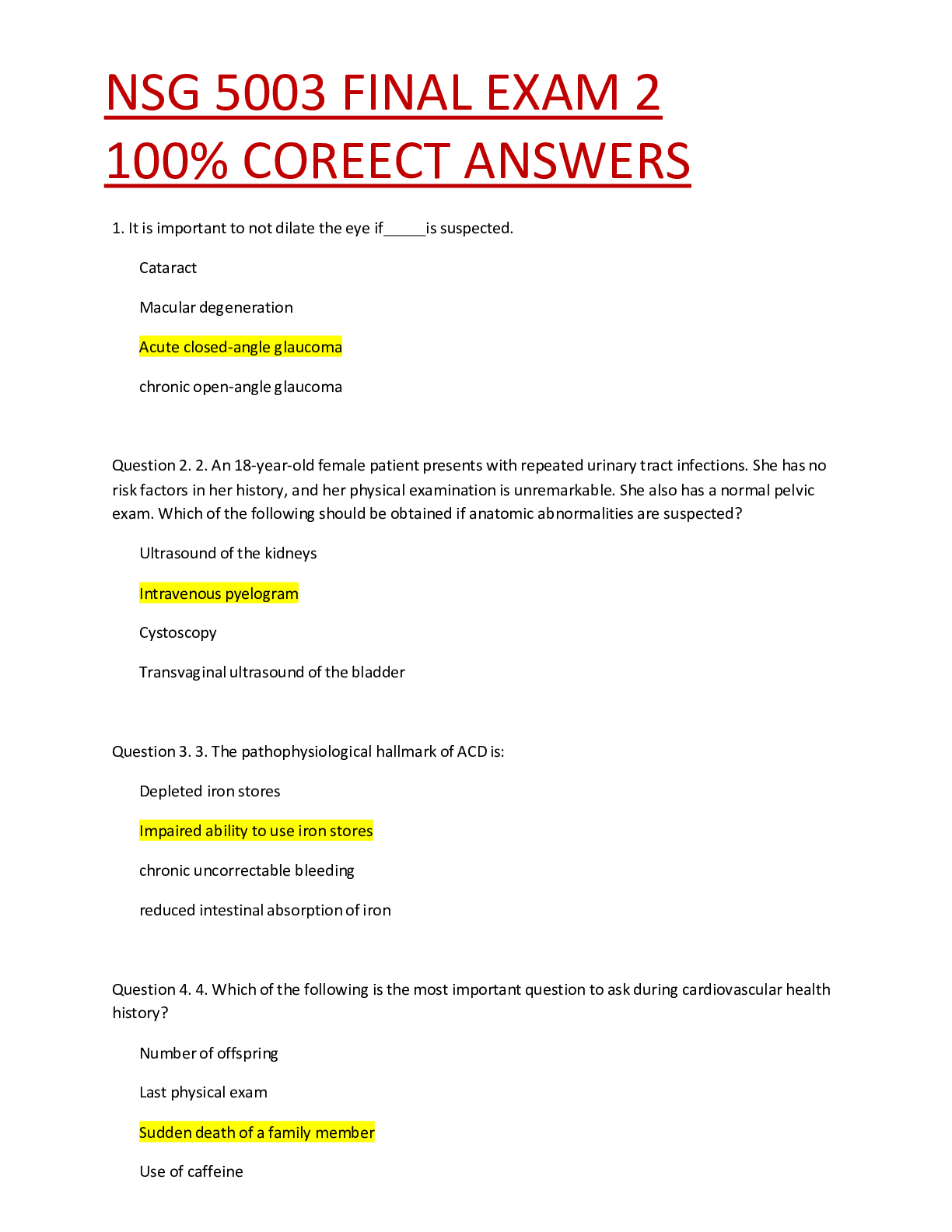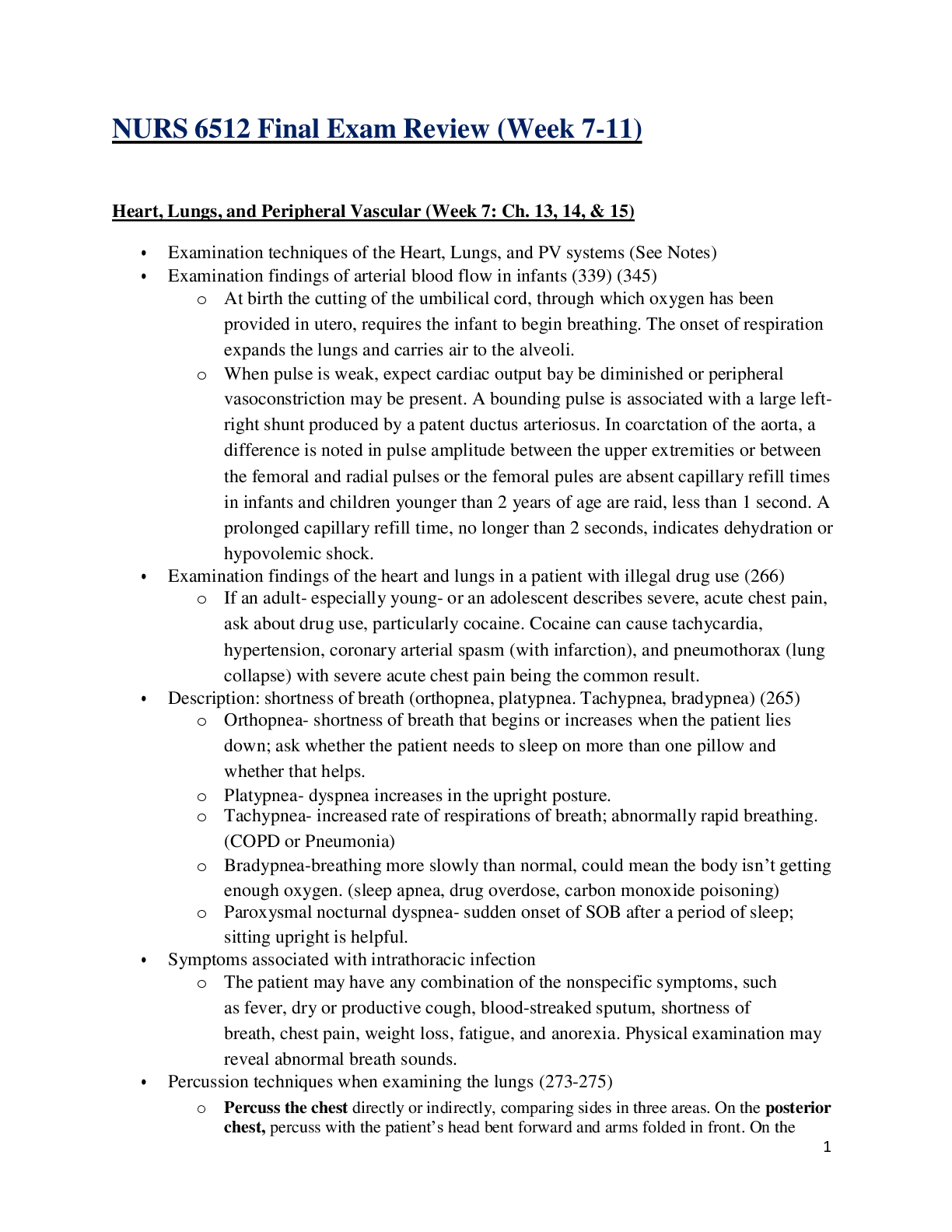*NURSING > Final Exam Review > Med Surg 1 FINAL complete test (All)
Med Surg 1 FINAL complete test
Document Content and Description Below
Med Surg 1 FINAL For all areas and topics be sure to review Nursing Process: Class 1- Health Care Delivery/Concepts in Nursing/ Nursing Process (3-5 questions) Quality Care and Safety- National ... patient safety goals QSEN competencies Quality Safety and Education for Nurses • ) SBAR Components of Critical Thinking Nursing Process Learner Readiness • “ Teach Back Class 2- Asepsis, Safety, Hygiene and skin care- (2-3 questions) Precautions Factors that attribute to falls/fall prevention o Fall Pressure injuries o Stage 1Pain- Ch. 12 (2-4 questions) Nociceptive pain- (acute) Somatic— Neuropathic pain – (chronic . Pain Assessment Scales Components of Pain Assessment Pain management: Fluid & Electrolytes/ Acid-Base Imbalances- Ch. 13 (5-7 questions) Homeostatic mechanisms: Kidney— Adrenal gland Lungs— Parathyroid— Pituitary— through kidneys Normal Urine output = 1500mL/day – 30mL/hour Management Management Assess and monitor patient response Intake & Output, VS, Daily wgt (1 L= 2.2 kg) Skin turgor, tongue and mucosa, urine output, mental status Measures to minimize fluid loss Administration of oral fluids Administration of parenteral fluids Oral care Assess and monitor patient response I&O, VS and daily weights Assess cardiac status, neuro, lung sounds, edema, other symptoms Skin care, positioning/turning patient/family teaching related to sodium and fluid restrictions Normal Blood Lab Values Electrolyte and Normal Value Abnormality Cause Assessment Management Sodium (Na) 135mEq/L-145 mEq/L Dietary changes- low sodium diet, excessive plain water intake- GI losses-vomiting, diarrhea, GI suctioning, Renal losses-diuretics, Hormonal influences- ADH, SIADH, Water restriction, sodium replacement Assessment, follow labs mental status changes, and prevention Monitor fluid intake and dietary sodium Identify, monitor at-risk patients effects of medications (diuretics, lithium) Hypernatremia Sodium >145mEq/L Electrolyte and Normal Value Abnormality Cause Assessment Management GI losses (vomiting, diarrhea, suctioning), medications, acid–base balance alterations, hyperaldosteronism, poor dietary intake Assessment (severe hypokalemia- life-threatening) monitor EKG; arterial blood gases (ABGs), dietary potassium, IV potassium administration Potassium replacement; Increase dietary potassium IV for severe deficit Hyperkalemia Serum potassium > 5.0 mEq/L dysrhythmias, EKG changes; muscle weakness, numbness, tingling, anxiety, abdominal cramps, nausea, diarrhea Electrolyte and Normal Value Abnormality Cause Assessment Management Hypocalcemia Serum level < 8.5 mg/dL seizure precautions weight-bearing exercises to decrease bone calcium loss patient teaching related to diet and medications. Nursing care related to calcium administration IV IV calcium gluconate; Dietary consult Calcium 1000mg -1500 mg daily (in divided doses) vitamin D 400-600 IU daily (enhances Ca absorption) Malignancy, hyperparathyroidism, bone loss related to immobility, high calcium intake, thyroid disorders Electrolyte and Normal Value Abnormality Cause Assessments Management Magnesium (Mg) 1.8-3.0 mg/dL Assess and monitor patient PO/IV replacement Monitor patient during IV replacement Renal failure, DKA or excessive antacid use Metabolic Acidosis Low pH < 7.35 Low HCO3 < 22 Cause: Renal Failure, GI loss- diarrhea Manifestations: Headache, confusion, Inc. Respiratory rate, Dec. Blood pressure, cool and clammy skin, Hyperkalemia, Hypocalcemia Treatment: Correct imbalance, administer bicarbonate, treat hyper/hypokalemia- MONITOR Potassium and Calcium Respiratory Acidosis Low pH < 7.35 High PaCO2 > 45 Causes: HYPOVENTILATION (from drug overdose, chest trauma, Pulmonary edema, COPD, Neuromuscular disease) Manifestations: Inc. Heart rate, Resp rate and BP, Hyperkalemia, increased intracranial pressure Treatment: Ventilation Perioperative Care- Ch. 17, 18, 19 (7-9 questions) PHASES Preoperative- PREOP CARE INFORMED CONSENT- physician obtained, nurse may be witness, nurse ensures consent form is signed before pre-medicating patient TEACHING ASSESSMENT RISK FACTORS Preventing Atelectasis Deep Vein Thrombosis Preventing Deep Vein Thrombosis • . INSTRUCTIONS TO PREVENT COMPLICATIONS POST OP o ” INTRA OP ROLE OF NURSE PROTECTING THE PT INTRA OP COMPLICATIONS Malignant Hyperthermia- Critical Complication high mortality rate- life threatening if unrecognized *abnormal release of calcium- damages CNS Signs and Symptoms of Malignant hyperthermia- tachycardia and generalized muscle rigidity often earliest signs Initial [Show More]
Last updated: 2 years ago
Preview 1 out of 28 pages
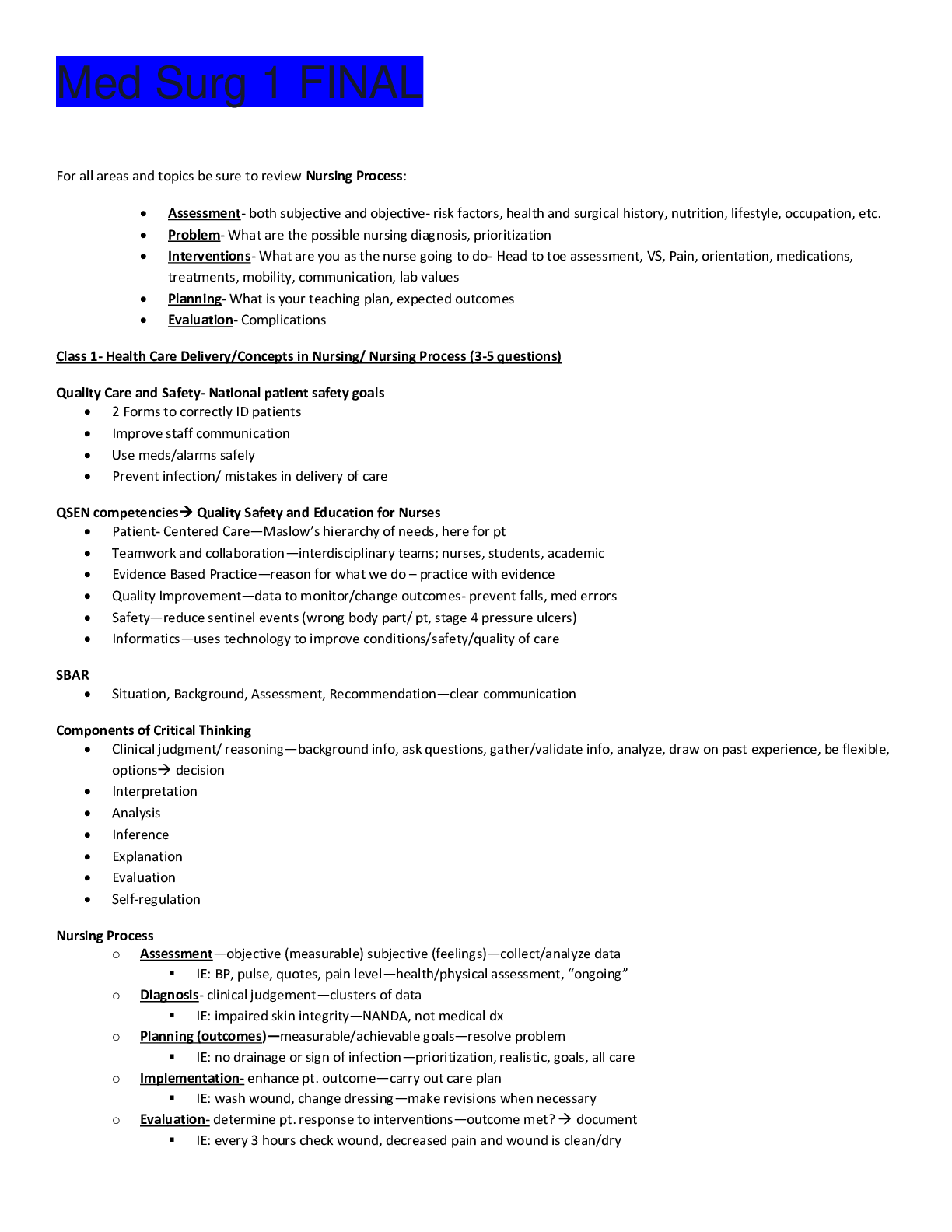
Buy this document to get the full access instantly
Instant Download Access after purchase
Buy NowInstant download
We Accept:

Reviews( 0 )
$15.00
Can't find what you want? Try our AI powered Search
Document information
Connected school, study & course
About the document
Uploaded On
Jan 09, 2021
Number of pages
28
Written in
Additional information
This document has been written for:
Uploaded
Jan 09, 2021
Downloads
0
Views
117

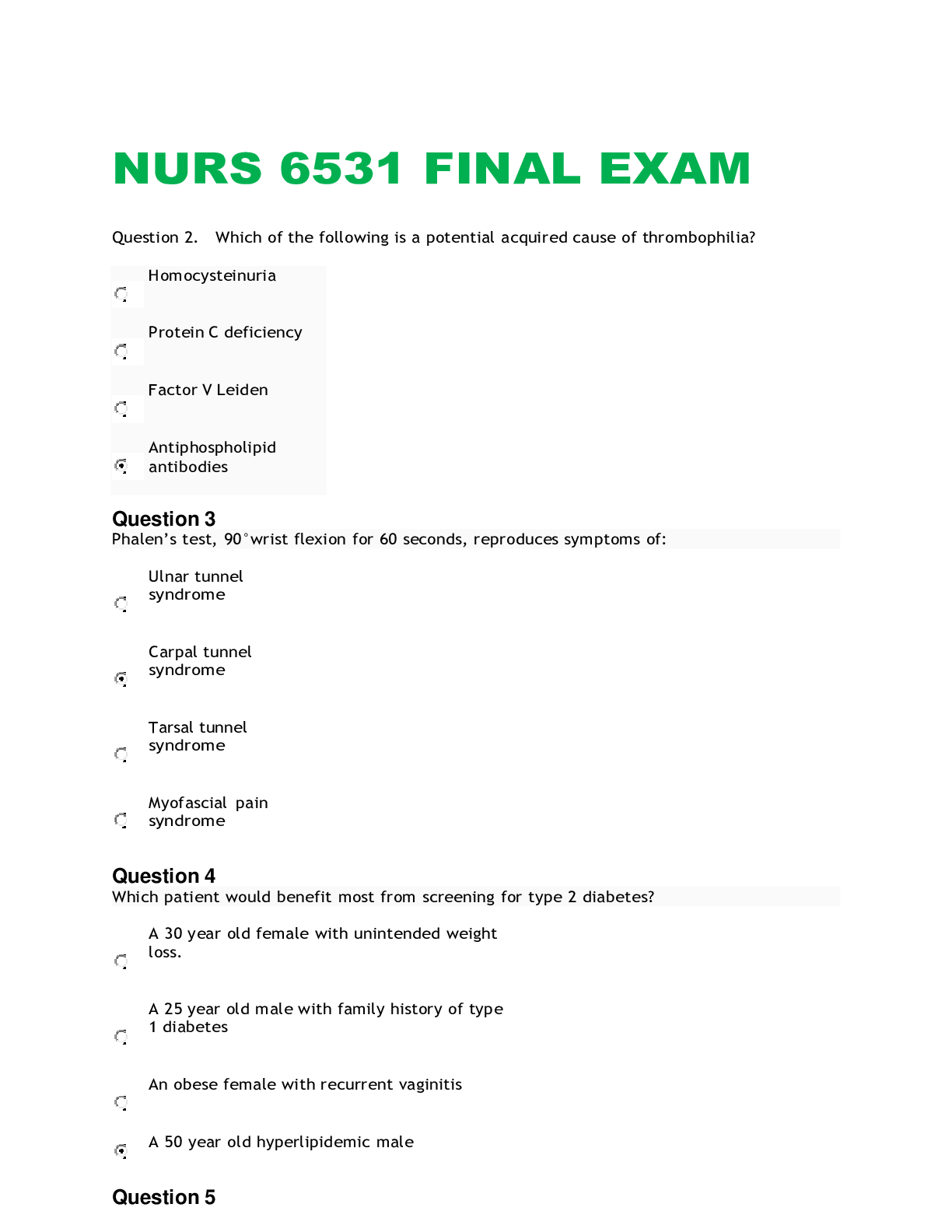


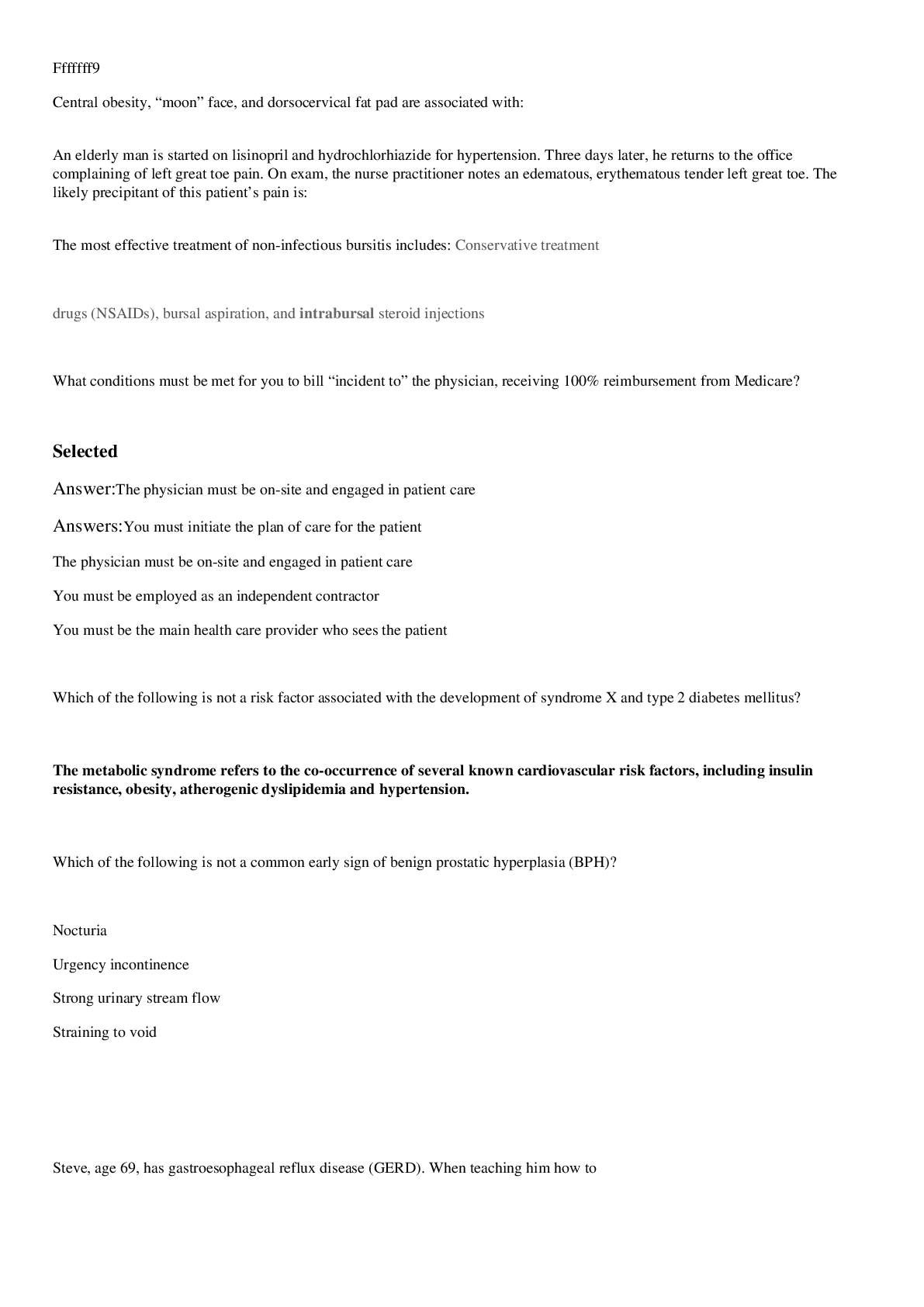












.png)
.png)
